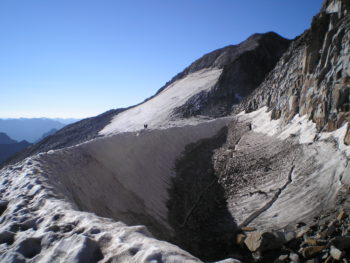With a surface area of 90 hectares and a maximum thickness of 50 metres, Aneto Glacier is the largest body of ice in the Pyrenees, forming part of the Natural Monument of the Pyrenean Glaciers.
A glacier is a large perpetual body of ice that moves downhill, just as if it were a fluid, a movement that is unnoticeable to the naked eye but that can be measured over the course of years. These large chunks of ice act as enormous diggers, ripping out rocks and being one of the main causes of erosion and the creation of new formations in the high mountains.
Do we have to walk on the glacier?
If you want to reach the top of Aneto, you will have to walk on ice and snow. Whichever route you choose to the summit – whether the southern route or the one up the north face – you will pass over Aneto Glacier. Even in summer when the snow has disappeared, what you see is the pure ice of the glacier, which is extremely hard and slippery. This means that it is vital to take an ice axe, crampons and helmet with you as part of your equipment in order to successfully complete this activity.
If you are starting in La Besurta in the summer, you will find snow by the time you reach Portillón Superior in June, and a little further ahead as summer progresses. It does not usually snow towards the end of the summer season, but you will have to cross over the glacier (although you should avoid it as much as you can).
Seeing the footprints of other mountaineers in the ice often lulls you into a false sense of security, making you lower your guard. However, don’t think that you are in the clear: you will still need to use your ice axe and crampons.
What if I climb the south face?
If you decide to start in the south (Puente de Coronas, Vallibierna), you will still have to pass over snow or ice, as this route joins up with the northern route at Collada de Coronas. Once here, you will still have the steepest part of the glacier ahead of you. In addition, depending on the month of your trip, it is highly probable that you find snow even at Ibón Superior de Coronas.
As well as taking with you an ice axe, crampons and a helmet, you will also need trousers and a long-sleeved top. If you were to slip and fall uncontrollably, your helmet would protect your head against possible blows, while your long clothes would keep you from scratching and scraping your skin on the snow before performing a self-arrest with the ice axe.
Remember that it’s not just a matter of taking safety equipment with you (ice axe and crampons), you also need to know how to use it. On the way up Aneto is not the best place to learn how to use such technical devices.
| La Renclusa | Puente de Mahoma |

